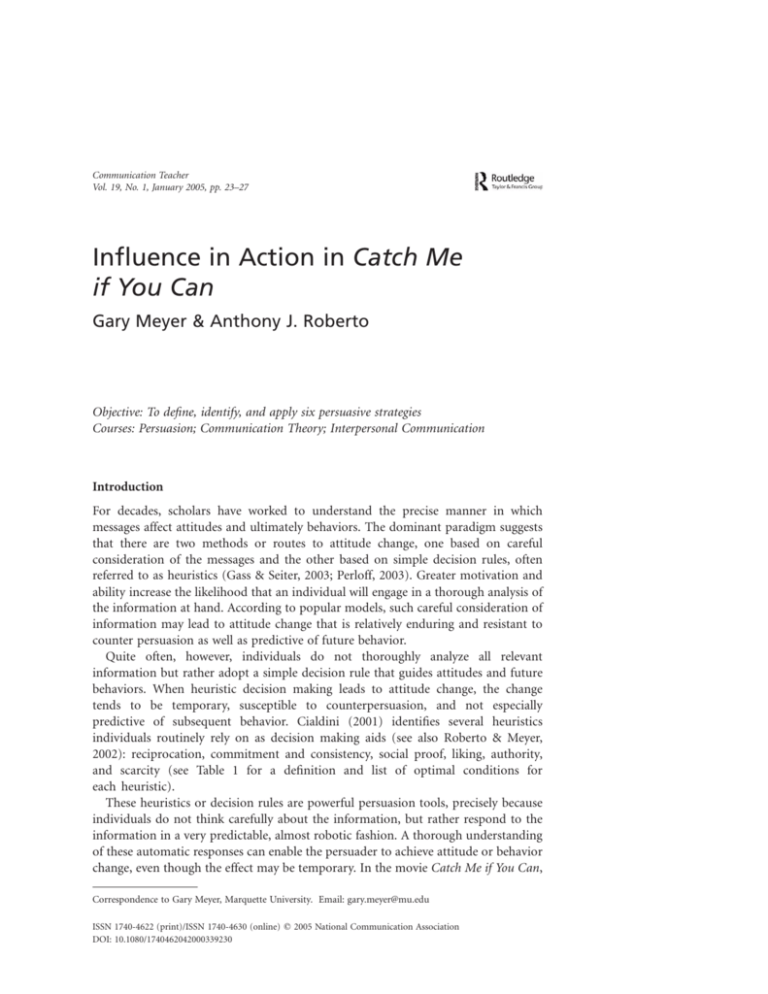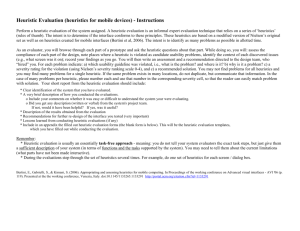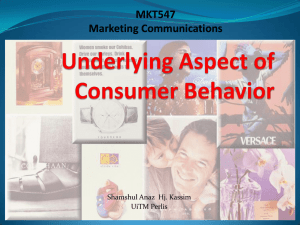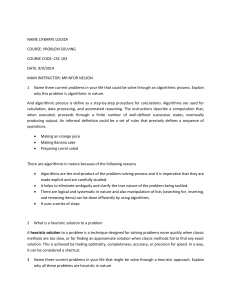Influence in Action in Catch Me if You Can
advertisement

Communication Teacher Vol. 19, No. 1, January 2005, pp. 23–27 Influence in Action in Catch Me if You Can Gary Meyer & Anthony J. Roberto Objective: To define, identify, and apply six persuasive strategies Courses: Persuasion; Communication Theory; Interpersonal Communication Introduction For decades, scholars have worked to understand the precise manner in which messages affect attitudes and ultimately behaviors. The dominant paradigm suggests that there are two methods or routes to attitude change, one based on careful consideration of the messages and the other based on simple decision rules, often referred to as heuristics (Gass & Seiter, 2003; Perloff, 2003). Greater motivation and ability increase the likelihood that an individual will engage in a thorough analysis of the information at hand. According to popular models, such careful consideration of information may lead to attitude change that is relatively enduring and resistant to counter persuasion as well as predictive of future behavior. Quite often, however, individuals do not thoroughly analyze all relevant information but rather adopt a simple decision rule that guides attitudes and future behaviors. When heuristic decision making leads to attitude change, the change tends to be temporary, susceptible to counterpersuasion, and not especially predictive of subsequent behavior. Cialdini (2001) identifies several heuristics individuals routinely rely on as decision making aids (see also Roberto & Meyer, 2002): reciprocation, commitment and consistency, social proof, liking, authority, and scarcity (see Table 1 for a definition and list of optimal conditions for each heuristic). These heuristics or decision rules are powerful persuasion tools, precisely because individuals do not think carefully about the information, but rather respond to the information in a very predictable, almost robotic fashion. A thorough understanding of these automatic responses can enable the persuader to achieve attitude or behavior change, even though the effect may be temporary. In the movie Catch Me if You Can, Correspondence to Gary Meyer, Marquette University. Email: gary.meyer@mu.edu ISSN 1740-4622 (print)/ISSN 1740-4630 (online) q 2005 National Communication Association DOI: 10.1080/1740462042000339230 24 Communication Teacher Table 1 Influence in Action in Catch Me if You Can Principlea Examples used by Frank Abagnale Jr. in Catch Me if You Can (scene number in parentheses) Reciprocity: We should try to repay, in kind, what another person has provided us. This rule is overpowering, can create uninvited debts, and can trigger unfair exchanges † Gave necklace to flight attendant who later became intimate with Frank (8) † Told Handratty he would tell how he passed the Bar exam if he shared his Éclair (14) † Told the teller he wanted to take her out for a steak dinner so she would cash his check without identification (8) Commitment and Consistency: Once a choice is made, we will encounter personal and interpersonal pressure to behave consistently with that commitment. The effects are strongest when a commitment is put in writing, made publicly, involves great effort, or is freely chosen. † Frank first had the teller cash check (commitment), then had her tell him all about bank operations (consistency) (8) † First asked Brenda if she loved him (commitment), then made her promise to follow him to the airport (consistency) (16) Social Proof: We view a behavior as correct in a given situation to the degree that we see others performing it. The effects of social proof are strongest when we are uncertain of ourselves or observing similar others engaging in a behavior. † Watched TV shows to see how doctors and lawyers behaved so he could act properly in the hospital and courtroom (13/14) † Frank mimicked girlfriend’s family during sing-a-long when uncertain how to behave (14) Liking: We prefer to say yes to individuals we know and like. We tend to like people who are physically attractive, similar to us, compliment us, or are familiar to us. † Physical attractiveness—Frank was a good looking guy; used attractive flight attendants to distract police (17) † Compliments—Told the bank teller she had pretty eyes to get her to cash check against bank policy (i.e., without ID) (7) † Similarity—Said he was a lawyer and a Lutheran to get finance’s family to like him (14) † Familiarity—Frank addressed people by their first names to seem more familiar (Various scenes) Authority: We have a deep-seated sense of duty to authority. Symbols of authority include titles, clothes, and other “trappings” (i.e., cars, jewelry, etc.). † Titles—Referred to himself as a doctor and created false diploma and resume to convince people he was a physician (13) † Clothing—Used a uniform to make people think he was a pilot; suit made students think he was a substitute teacher (13) † Trappings—Used expensive cars throughout (Various scenes) † Other—Frank used jargon to sound like a substitute teacher, pilot, doctor, and lawyer (13) Communication Teacher Scarcity: Opportunities seem more valuable to us when they are less available. We will want an item most when it is newly scarce or when we must compete for it. a 25 † Limited numbers and competition— Over 100 college women competed for eight spots at flight attendant competition (17) † Limited time—Frank noted his flight took off in three hours and desperately needed a uniform (7) Descriptions of these principles are adapted from Cialdini (2001) and Roberto and Meyer (2002). several characters have an excellent understanding of these heuristics. And because the characters invoke them on numerous occasions in a variety of contexts, the film provides an excellent opportunity to see influence in action. This is true especially of the lead character, Frank Abagnale, Jr., who intuitively applies his knowledge of heuristic decision making to influence those around him. Multiple examples of each decision rule can be found in Catch Me if You Can, the film that serves as the basis for this exercise. This film documents the true escapades of a young con artist who skillfully convinced others that he was an airline pilot, physician, and lawyer all while passing millions of dollars in bad checks. Activity This activity is best completed after students have a thorough understanding of heuristic decision making models (e.g., Gass & Seiter, 2003, Chapter 5; Perloff, 2003, Chapter 5). Additional primary research articles (e.g., Chaiken, 1980) or advanced readings (e.g., Petty & Cacioppo, 1986) can also be assigned to make the activity more challenging. At a minimum, students should be able to clearly delineate the difference between message processing based on a careful analysis of all information and message processing based on a decision rule of some type. Begin by distributing a blank version of table 1 to all students and have them define all six heuristic persuasive strategies in the left-hand column. After students have defined the key terms, show selected scenes (or the entire movie if desired) from Catch Me if You Can. If time is limited, instructors may show DVD tracks 6 –8 (13 minutes) and 13–17 (39 minutes) as they incorporate excellent examples of each heuristic. In this case, however, instructors may want to give an overview of what has occurred up to that point in the film to provide students with an adequate context for the scenes. While viewing the movie, students should identify and describe multiple situations evidencing the various strategies in the right-hand column of table 1. Afterward, students will have an opportunity to share with classmates instances of the heuristics they identified. One variation of this activity is to have students watch the entire movie at home, and then discuss the examples in class (though it is strongly recommended that the discussion be supplemented with at least a few excerpts from the movie). At a minimum, the activity will require one class period, although it could easily be expanded to two or more class periods if desired. 26 Communication Teacher Debrief Debriefing should begin after all terms have been defined, and students have had an opportunity to share one or more situations focused on heuristic decision making (table 1 provides several useful examples). Students should identify the heuristic and describe the situation. After doing so, the instructor may focus on the following questions to aid the debriefing discussion: 1. How effective was the persuasion that occurred through heuristic decision making? Which heuristic, if any, seemed most effective? 2. Which heuristic seemed to be used most frequently by Frank Abagnale, Jr.? Why do you think this heuristic was used more than the others? Strive to identify both illegitimate and legitimate uses of these heuristics (i.e., Frank used symbols of authority to pretend to be a substitute teacher, airline pilot, doctor, and attorney, all illegitimate authority, but became a legitimate authority on bank fraud and forgery by the end of the movie). 3. Can you identify specific examples of heuristic decision making in other movies? 4. Do you most typically make decisions only after carefully considering all relevant information, or do you most typically rely on heuristics? From recent experiences, give an example of each type of message processing in your life. 5. Provide an example of a time you used one of these persuasive strategies to encourage the use of heuristic message processing in another person. 6. Do you believe persuasion strategies focused on heuristic decision making are any more or less ethical than persuasion strategies focused on a thorough analysis of all relevant information? Appraisal There are some challenges associated with implementing this activity. First, there is the preparation time involved. The instructor should preview the entire movie, or at a minimum preview those segments that will be shown to the entire class. In this latter case, the use of DVD technology is recommended, as it will reduce the amount of inclass time spent finding the exact scenes of the movie to show. A thorough review should also be undertaken, as some of the language and adult themes may be inappropriate, especially for use in K-12 classes. Finally, instructors must commit to the use of at least one full class period to achieve the stated objective. These challenges aside, there are several notable strengths associated with this activity. First, it provides students with numerous interesting “real life” examples of influence in action; that is, the application of theoretical persuasion principles within the context of a story (film) based largely in fact. Second, the exercise gives students the opportunity to review strategy definitions from assigned readings and, perhaps even more importantly, the opportunity to identify examples of such strategies in a fun and exciting manner. Third, through discussion, students will share the many situations that exemplify each heuristic and through others learn about other Communication Teacher 27 situations that they missed. Finally, the activity is flexible and thus permits instructors to modify it in several ways to best fit their needs. Instructors, for example, may show as many or as few movie segments as desired. Rather than debriefing as an entire class, the instructor could create small groups. Each group could be assigned a particular heuristic to discuss or be asked to discuss all heuristics, but in either case, groups would report out after group discussion. References and Suggested Readings Chaiken, S. (1980). Heuristic versus systematic information processing and the use of source versus message cues in persuasion. Journal of Personality and Social Psychology, 39, 752– 766. Cialdini, R. B. (2001). Influence: Science and practice (4th ed.). Boston: Allyn & Bacon. Gass, R. H., & Seiter, J. S. (2003). Persuasion, social influence, and compliance gaining (2nd ed.). Boston: Allyn & Bacon. Perloff, R. M. (2003). The dynamics of persuasion: Communication and attitudes in the 21st Century. Englewood Cliffs, NJ: Lawrence Erlbaum. Petty, R. E., & Cacioppo, J. T. (1986). The elaboration likelihood model of persuasion. In L. Berkowitz (Ed.), Advances in experimental social psychology, (Vol. 19, pp. 123– 205). New York: Academic Press. Roberto, A. J., & Meyer, G. (2002). Influence in action: A student handbook. Boston: Allyn & Bacon.








